In the heart of the Himalayas lies a valley of unparalleled beauty. It is a place where nature's grandeur meets the delicate artistry of human hands. Welcome to Kashmir, a region adorned with picturesque landscapes and heritage as rich and intricate as the Pashmina that graces its chilly winters.
Nestled between snow-capped peaks, Kashmir Valley has long been a cradle of culture, tradition, and exquisite craftsmanship. Let's embark on a journey through time, where the tale of Pashmina unfolds against the backdrop of this enchanting valley.
Pashmina Unveiled: A Symphony of Softness and Luxury
As the chilly breeze sweeps through the Himalayan foothills, it carries with it the essence of Pashmina. Pashmina is the art, renowned for its luxury soft, extraordinarily warm, and undeniably luxurious products. Its raw material Cashmere comes from the fine undercoat of the Changthangi goats. These goats graze in the high-altitude plateaus, after bearing immensely harsh climatic conditions. This makes Pashmina not just an art form but an embodiment of comfort and sophistication.
Tracing Roots
The origin of Pashmina has deep roots in centuries of tradition and cultural significance. Dating back to ancient times, the art of crafting Pashmina found its home in the hands of Kashmiri artisans. Legend has it that the craft was introduced to the region by Persian influence, flourishing and evolving over generations. Fortunately, Kashmir's climate and terrain proved to be the perfect nurturing ground for the exceptional wool produced by the Changthangi goats. Hence, these conditions lay the foundation for a textile legacy that would become synonymous with the region.
A Heritage Woven in Time: Kashmir and its Pashmina Saga
Pashmina, in the context of Kashmir, goes beyond being material. In fact, it is a living heritage, intricately woven into the fabric of daily life, ceremonies, and cultural events. The valley resonates with the gentle hum of looms. Artisans meticulously transform raw Cashmere wool into exquisite shawls and scarves, each bearing the soul of Kashmir's artistic identity.
As we delve deeper into this tale of craftsmanship and culture, the very essence of Kashmir and its Pashmina unfolds like a beautifully woven shawl. Further, it reveals the threads that bind history, tradition, and the timeless allure of luxury.
Early References to Pashmina
The historical significance of Pashmina can be traced through the corridors of time. It finds its earliest mentions in the annals of history and cultural narratives. The luxurious fabric was highly coveted, even in ancient times, for its unparalleled softness and warmth. Early references in historical texts and manuscripts often highlighted the esteemed status of Pashmina. Also, these underline the exceptional qualities of Pashmina that set it apart from other counterparts.
In the epochs preceding the modern era, traders traversed treacherous mountain terrains, forging ancient trade routes to bring Pashmina to distant lands. The mere mention of Pashmina invoked a sense of opulence and exclusivity. Moreover, it captivated the imaginations of those who sought the finest fabrics the world had to offer.
Also read: PASHMINA SHAWL: TESTIMONY OF THE TRAVELERS
The Regal Embrace: Royal Patronage in Kashmir
Kashmir, with its breathtaking landscapes and thriving artistic community, became the nurturing ground for Pashmina's ascendancy to regal elegance. The art form found its way into the courts of Kashmir's rulers. In fact, in these courts, it was embraced by royalty for its exceptional quality and luxurious feel. Soon, Pashmina became synonymous with sophistication. Furthermore, its association with nobility elevated it to the status of a textile fit for kings and queens.
Royal patronage has certainly played a pivotal role in the refinement and promotion of Pashmina craftsmanship. Artisans, fueled by the recognition and support of the ruling elite, honed their skills to perfection. Soon they started creating masterpieces that transcended mere garments. Pashmina shawls and wraps adorned the courts, becoming an integral part of Kashmiri's cultural identity. Also, these masterpieces set the stage for the fabric's enduring legacy.
Threads of Tradition: Cultural Importance of Pashmina in Kashmir
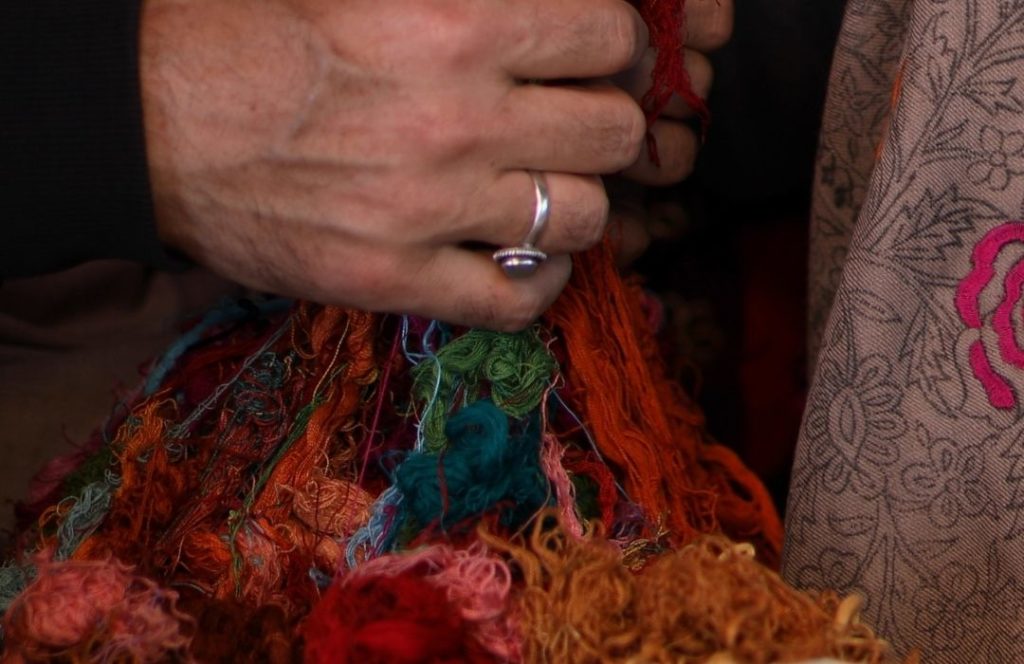
Beyond the confines of regal chambers, Pashmina seamlessly interwove itself into the rich tapestry of Kashmiri traditions. Cashmere fabric became an integral part of ceremonies, rituals, and cultural events, hence, symbolizing not just luxury but also heritage and identity. Kashmiri weddings, in particular, witnessed the draping of intricately woven Pashmina shawls. These signified not only warmth but also the blessings of tradition.
In religious ceremonies and festivals, Pashmina finds its place, draping devotees in a cocoon of softness. This is done to pay homage to centuries-old customs. The cultural importance of Pashmina extended beyond its physical warmth. It became a bearer of stories as well as a custodian of traditions passed down through generations.
As we delve into the historical tapestry, each thread tells a story of opulence, refinement, and cultural significance. Pashmina has early mentions in ancient texts as it enjoyed a regal embrace in royal courts, seamlessly integrating into the fabric of Kashmiri traditions. Hence, Pashmina emerges not just as art but as a living testament to the enduring legacy of craftsmanship and culture.
The Production Process of Pashmina
The meticulous process of Pashmina production is worth cherishing, even more than the result. Here is the step-by-step procedures of how Cashmere wool is grown on the body of the goat. It also shows how it turns into the ever-luxurious shawls.
The Goat
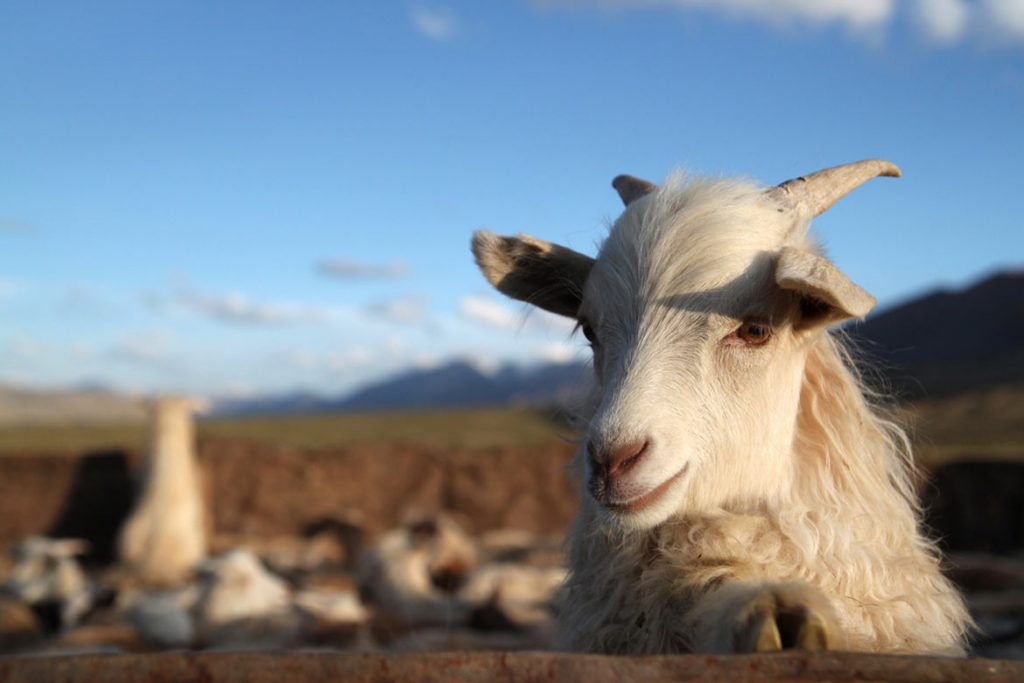
In the Himalayan region, thriving amidst the challenging terrains of Ladakh and Tibet, reside the extraordinary Changthangi goats. These resilient animals have adapted to the harsh conditions of high altitudes. Their exceptional wool, known as Cashmere, forms the cornerstone of the illustrious Pashmina shawls.
The wool from Changthangi goats is nothing short of a treasure, celebrated for its unmatched softness, fineness, and insulation properties. These goats have evolved to develop a luxuriously soft undercoat. This helps them to combat the biting cold, hence making their wool a coveted commodity in the world of textiles. The geographical and climatic factors of their habitat contribute significantly to the quality of Cashmere, rendering it finer and softer than that of other breeds.
The Changthangi goats undergo an annual molting process during the spring, shedding their winter coats naturally. It is during this period that skilled herders carefully harvest the precious Cashmere wool. What sets this breed apart is not only the softness of their wool but also the minimal coarseness. These factors make it an ideal raw material for crafting shawls.
The Challenging Environment
The remote and challenging environment in which the Changthangi goats thrive plays a pivotal role in enhancing the quality of their wool. The high altitudes, extreme temperatures, and scarce vegetation contribute to the development of Cashmere fibers. Although harsh, these conditions make the wool exceptionally fine and warm. The very essence of Pashmina's luxurious appeal lies in the unique characteristics of the wool sourced from these goats.
As guardians of this prized resource, herders engage in a delicate process of combing rather than shearing. This ensures the preservation of the integrity of the fibers. This humane and meticulous approach not only safeguards the well-being of the goats but also maintains the exceptional standards that define Pashmina.
Harvesting: Pashmina Wool Collection
The journey from the rugged terrains of the Himalayas to the creation of a Pashmina shawl is indeed a tale of meticulous artistry and dedication. At the heart of this process lies the careful and considerate harvesting of Cashmere wool. Indeed, it is a practice that embodies the essence of luxury and sustainability.

Unlike conventional shearing, the method employed for collecting Cashmere wool is a gentle and intricate process involving combing. This approach ensures not only the preservation of the delicate fibers but also the well-being of the Changthangi goats. Note that the goat is the only source of this prized wool. The choice of combing over shearing is driven by a commitment to ethical and humane practices. These align with the essence of Pashmina craftsmanship.
The harvesting season typically unfolds during spring when the Changthangi goats naturally shed their winter coats. This annual molting process is a crucial moment in the production of Pashmina. Also, it marks the beginning of a series of careful and deliberate steps. Herders, often skilled artisans themselves, use specialized combs to gently remove the fine undercoat. Note that gentle combing does not cause any distress to the animals.
The combing process demands patience and expertise, as artisans navigate through the dense fleece to extract the precious fibers. This manual and meticulous approach not only ensures the humane treatment of the goats but also contributes to the preservation of the exceptional qualities that define Cashmere wool.
Processing the Wool
The collected wool, soft and downy, undergoes further sorting to separate the finest fibers from the coarser outer layers. This meticulous sorting process is a testament to the commitment to quality that characterizes the Pashmina industry. The fine fibers are then ready for the subsequent stages of spinning and weaving. There, weavers transform fibers into exquisite Pashmina shawls.
The Art of Spinning
The journey of Pashmina from the high plateaus of the Himalayas to the creation of its luxurious shawls involves an intricate dance of hands, threads, and tradition. The artistry continues as skilled artisans take center stage. They employ time-honored techniques of spinning and weaving to bring the ethereal fabric to life.
The first step in transforming Cashmere wool into the delicate fabric that graces shawls is spinning. Traditionally, this process is carried out by hand, underscoring the artisanal nature of Pashmina production. Skilled spinners, often with years of experience passed down through generations, carefully tease out and twist the fine fibers to create a thread of unparalleled fineness.
The choice of hand spinning is intentional. It allows artisans to control the tension and thickness of the yarn with a precision that machines cannot emulate. This intimate involvement in the spinning process ensures that each strand maintains the integrity of the wool, resulting in a yarn that is not only soft and lightweight but also possesses the distinctive warmth that defines Pashmina.
The Loom: A Canvas of Tradition
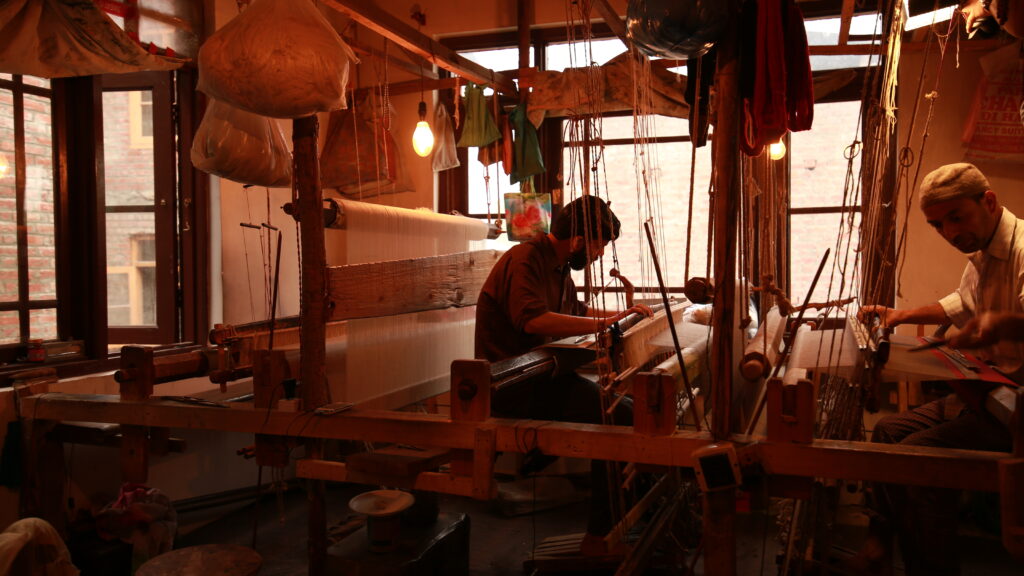
Once the threads are spun, the artistry shifts to the loom, where the skilled weavers weave their magic. The loom, often a handloom, becomes a canvas for the intricate patterns and designs that characterize Pashmina shawls.
Weaving Pashmina is a meticulous process that demands both skill and patience. The delicate nature of the yarn requires a gentle touch, ensuring that the final fabric retains its softness and luster. Artisans employ various traditional weaving techniques. These include the classic twill weave and the intricate jacquard weave, each adding its unique touch to the finished product.
The loom becomes a stage for creativity as artisans bring forth traditional Kashmiri patterns, paisley motifs, and other intricate designs. The weaving process involves a deep understanding of the wool's behavior. This allows artisans to create a fabric that is not just a shawl but a piece of wearable art.
In the hands of skilled artisans, spinning and weaving become more than just processes. In fact, they become acts of storytelling, preserving the rich heritage of Pashmina. As the loom creates intricate patterns, it weaves together tradition, art, and luxury, culminating in the creation of a Pashmina shawl. The final product is not just an accessory but a testament to the enduring craftsmanship of Kashmir.
The Craftsmanship
The production of Pashmina shawls is a symphony of artisanal techniques, each contributing to the exquisite beauty of the final product. Weaving, embroidery, and dyeing are integral aspects of this craftsmanship, transforming raw Cashmere wool into wearable pieces of art.
Weaving
At the heart of Pashmina craftsmanship lies the skillful art of weaving. The loom becomes a canvas, and artisans paint intricate patterns and designs with threads. Traditional weaving techniques, add texture and depth to the fabric, hence creating a visual feast for the eyes. The weaving process, further, demands precision and patience, as each thread is carefully intertwined to form the delicate yet durable Pashmina fabric.
Embroidery
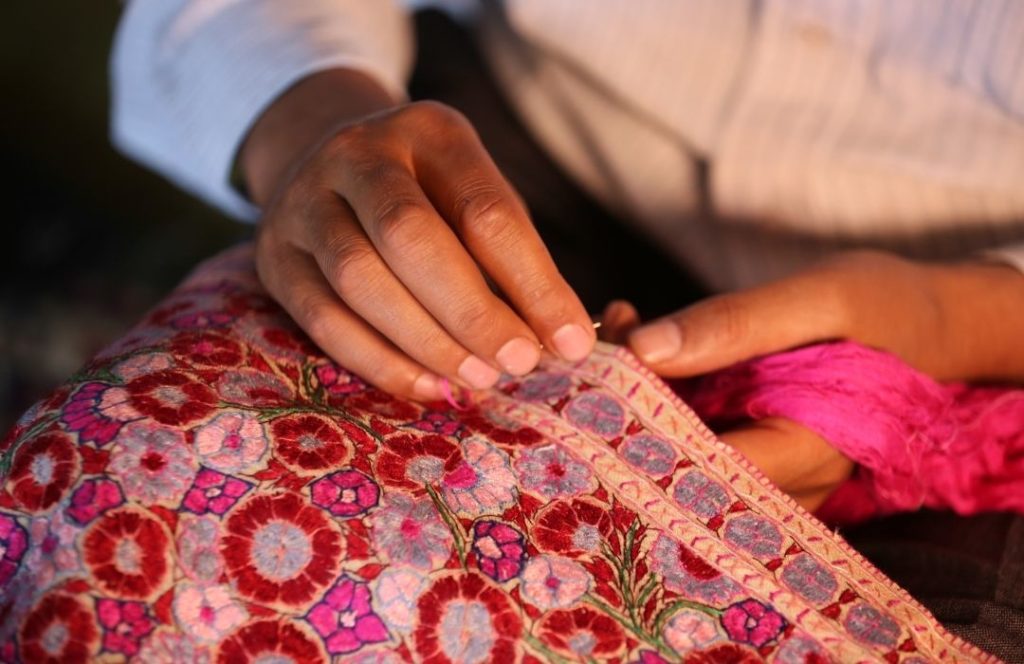
The art of embroidery elevates Pashmina to new heights of opulence. Sozni embroidery, Tilla embroidery, and Papier Mache embroidery are among the exquisite techniques employed by Kashmiri artisans. These intricate embroideries adorn the shawls, hence adding a touch of luxury and cultural richness. The detailed handwork showcases the artisan's mastery, thereby turning every Pashmina piece into a work of wearable art.
Dyeing
The dyeing process is a crucial step that imparts vibrant colors to Pashmina shawls. Artisans use both traditional and modern dyeing methods to achieve a spectrum of colors, from deep burgundy to soft pastels. Natural dyes sourced from plants, minerals, and insects are often preferred, highlighting the commitment to sustainable practices. Shibori dyeing and ombre dyeing are some of the techniques that add a contemporary twist to the traditional art of Pashmina dyeing.
Handmade Excellence
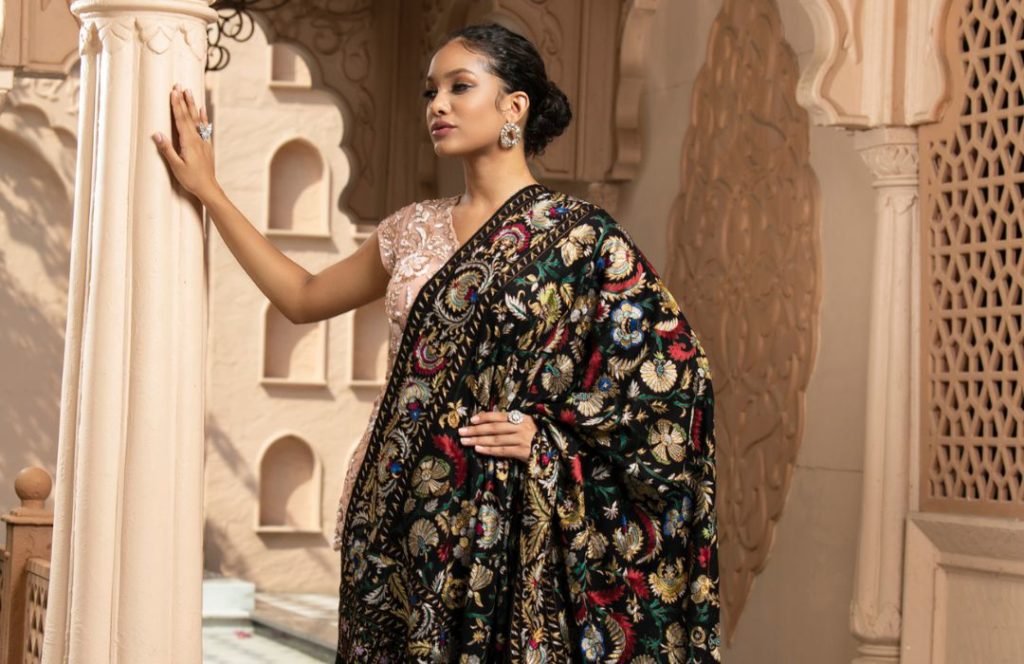
The true magic of Pashmina lies in the hands of Kashmiri artisans who bring their skills and heritage to every piece. These craftsmen, often belonging to generations of Pashmina artisans, carry forward a legacy that transcends time. Their hands weave stories into the fabric, and their eyes discern the perfect harmony of colors.
The uniqueness of each Pashmina shawl is a testament to the handmade excellence that permeates every stage of its creation. From the careful selection of the finest wool to the meticulous craftsmanship of weaving and embroidery, these artisans invest their time, energy, and passion into crafting a masterpiece. It's not just a shawl; it's a labor of love, a reflection of centuries-old traditions, and a tribute to the artistic prowess of Kashmiri craftsmen.
In a world where mass production often dominates, Pashmina stands as a symbol of the enduring value of handmade excellence. Each shawl becomes a canvas where the artisan expresses their creativity, and each piece tells a story of the hands that crafted it—a story that echoes through the ages, connecting the wearer to the rich cultural tapestry of Kashmir.
Economic Impact on Kashmir: Nurturing Livelihoods through Pashmina
Employment and Livelihoods:
The Pashmina industry has been a steadfast pillar in sustaining livelihoods as well as generating employment opportunities for the people of Kashmir. From the pastoral communities engaged in herding Changthangi goats to the skilled artisans involved in the various stages of production, this industry has woven a tapestry of employment across the region.
The Changthangi goats, predominantly found in the high-altitude regions of Ladakh, provide the coveted Cashmere wool that forms the basis of Pashmina shawls. The pastoral communities, often nomadic in nature, play a vital role in the husbandry of these goats. They are not just keepers of a prized resource but also active participants in the intricate dance of sustainability that defines the Pashmina industry. The employment opportunities extend beyond the pastures to the artisanal hubs where skilled hands transform raw wool into the luxurious fabric that graces the world.
In the weaving and embroidery ateliers of Kashmir, skilled artisans lend their expertise to every Pashmina creation. The intricate Sozni embroidery, Tilla embroidery, and Kani weaving techniques are not just crafts but professions that have been passed down through generations. The employment of these artisans fosters a sense of community and continuity, preserving the cultural legacy of Kashmir.
Economic Significance:
The economic significance of Pashmina extends far beyond the borders of Kashmir, contributing substantially to the region's economy. Pashmina exports, characterized by the sale of shawls, scarves, and other Pashmina products, form a vital component of the trade landscape. The international demand for these exquisite pieces of craftsmanship not only brings economic gains but also elevates the global profile of Kashmiri handicrafts.
Pashmina's economic impact is not confined to the immediate trade transactions; it ripples through various sectors. The success of the Pashmina industry sustains auxiliary businesses, such as dyeing units, packaging services, and transportation networks. Additionally, the economic prosperity linked to Pashmina has a positive influence on local infrastructure, education, and healthcare, contributing to an overall improvement in the quality of life for Kashmiri communities.
As Kashmir navigates the complex terrain of economic challenges, the Pashmina industry remains a resilient force, fostering sustainable employment, cultural richness, and economic growth. This delicate fabric, woven with threads of tradition and commerce, continues to be a source of pride and prosperity for the people of Kashmir.
Preserving Pashmina Heritage
Role of Government:
The delicate artistry of Pashmina and its cultural significance has prompted the government to institute various initiatives aimed at safeguarding and promoting this invaluable heritage. Recognizing Pashmina as a national treasure, government interventions have been crucial in ensuring its continued vitality.

One of the pivotal steps taken by the government involves the granting of Geographical Indication (GI) tags to authenticate and protect Pashmina products. The GI tag serves as a hallmark of the product's origin, certifying that it is crafted in the traditional Pashmina-producing regions of Jammu and Kashmir. This not only shields the industry from counterfeit practices but also elevates the global standing of authentic Kashmiri Pashmina.
Financial support and subsidies have been extended to Pashmina artisans and herders, acknowledging their role in sustaining this age-old craft. These incentives act as a catalyst, encouraging the preservation of traditional techniques and ensuring that the intricate skills involved in Pashmina production are passed down through generations.
Community Involvement:
Preserving Pashmina heritage is not solely the responsibility of the government; active community involvement, often facilitated through cooperatives, plays a crucial role in sustaining these traditions. Cooperatives act as a bridge between the artisans and the market, providing a collective platform for Pashmina producers to share resources, insights, and support.
In a region where the Pashmina industry is deeply ingrained in the cultural fabric, these cooperatives serve as guardians of tradition. They facilitate skill development programs, ensuring that the intricate craftsmanship associated with Pashmina is preserved and refined. Furthermore, cooperatives create a sense of solidarity among artisans, fostering an environment where collective knowledge and experiences contribute to the evolution of the craft.
Community involvement extends beyond economic considerations. It encompasses the holistic well-being of the Pashmina-producing communities. Efforts are made to enhance the living standards of artisans, addressing aspects such as healthcare, education, and overall socio-economic development.
In the harmonious dance between government initiatives and community involvement, the delicate threads of Pashmina heritage are carefully preserved. As cooperatives weave together the past and the present, and government support fortifies the foundations, the future of Pashmina remains intricately connected to the collective efforts of those who cherish its heritage.
Also read: THE LEGENDS OF A KASHMIRI SHAWL
Pashmina in Contemporary Fashion: A Global Fashion Icon
Global Popularity:
From the serene valleys of Kashmir to the bustling streets of international fashion hubs, Pashmina has transcended regional boundaries to become a symbol of global elegance. The rich heritage and exceptional quality of Pashmina have captured the imagination of fashion enthusiasts worldwide, leading to its widespread popularity.
The global fashion industry has embraced Pashmina for its unparalleled softness, luxurious texture, and timeless appeal. Renowned fashion houses, designers, and influencers have played a pivotal role in propelling Pashmina into the limelight, making it a coveted accessory for individuals seeking both style and substance.
Integration into Modern Wardrobes:
In the dynamic realm of contemporary fashion, Pashmina has seamlessly integrated itself into modern wardrobes, offering versatility that complements diverse styles. While traditional shawls and wraps continue to be cherished, modern interpretations of Pashmina have emerged, catering to the preferences of a cosmopolitan audience.
Pashmina scarves, for instance, have become a staple accessory for individuals seeking sophistication in their everyday attire. The lightweight and breathable nature of Pashmina makes it a perfect year-round companion, providing warmth without compromising on style. Modern designs, vibrant colors, and innovative patterns have rejuvenated the Pashmina aesthetic, ensuring its relevance in the fast-paced world of fashion.
The adaptability of Pashmina extends beyond traditional ethnic wear. Pashmina-infused ensembles find a place in formal wear, casual outfits, and even high-end fashion events. Its ability to effortlessly elevate any look, coupled with an increasing emphasis on sustainable and ethically sourced fashion, has made Pashmina a choice that resonates with the contemporary values of consumers.
As Pashmina gracefully weaves through the tapestry of contemporary fashion, its enduring legacy remains intact. It stands not only as a testament to timeless craftsmanship but also as a dynamic and evolving expression of style that spans cultures and generations.
Also read: CASHMERE WRAP | CELEBRITIES WHO WORE CASHMERE
Conclusion
In the tapestry of Kashmir's cultural legacy, Pashmina emerges as a treasured thread, weaving a narrative of artisanal brilliance, historical significance, and contemporary allure. The celebration of Kashmir's Pashmina heritage is not merely a recognition of its past glory but a testament to its enduring importance in the global landscape.
The intricate craftsmanship, rooted in the hands of skilled artisans and the fleece of Changthangi goats, reflects a legacy that has transcended time. Pashmina's journey, from royal patronage to global runways, showcases its unwavering appeal and adaptability. It has become a symbol of Kashmir's rich cultural tapestry, a tangible representation of the region's artistry and resilience.
As we celebrate the Pashmina heritage of Kashmir, we also acknowledge its global allure. Pashmina has seamlessly integrated into the wardrobes of people worldwide, enchanting fashion enthusiasts with its unparalleled softness and timeless elegance. Its economic impact on Kashmir, its preservation through initiatives, and its contemporary relevance in fashion underscore its multifaceted significance.
In concluding this exploration, let us applaud the artisans who have kept the flame of Pashmina craftsmanship burning bright. Their dedication ensures that the legacy of Pashmina continues to thrive, leaving an indelible mark on the world stage. In celebrating Kashmir's Pashmina heritage, we honor not just a textile but a living testament to the art, culture, and resilience of a remarkable region.
Also read: 20 MOST ASKED QUESTIONS ABOUT PASHMINA AND CASHMERE